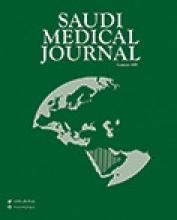Abstract
OBJECTIVE: To evaluate the incidence of scorpion stings and to draw the attention of clinicians, concerning the dilemma of scorpion sting syndrome and its management in the Kingdom of Saudi Arabia (KSA).
METHODS: In a retrospective survey, 251 cases were presenteds with scorpion stings to the Emergency Department of the Armed Forces Hospital, Riyadh, KSA during a period of 15 years (April 1986 to April 2000). Their ages ranged from 2 months to 101 years (male to female ratio was 2.6:1) and 70.6% of the cases were under 20 years of age.
RESULTS: The mean annual incidence of the scorpion sting in the month of May was 16.7%, with the highest mean percentage of approximately 36% each year. The seasonal sting cycle showed the highest record was in the summer period (51%) as compared to the lowest winter period (10%). Local pain was the primary presenting complaint (95%), with a total systemic toxicity of 78.3% and 35.2% of these were children. Hypertension, sweating, salivation and tachycardia were the most common signs of systemic symptoms. The majority of patients received analgesia, local anesthetics, and application of ice and a period of observation dictated by clinical findings. Eighty-two patients (32.6%) had signs of serious envenoming, requiring admission. There were no deaths. All of these cases were mainly treated symptomatically.
CONCLUSION: The beneficial effect of antivenom in protecting victims against scorpion stings is still questionable. The higher risk groups of systemic toxicity were either those with ages less than 10 years or greater than 50 years, being more susceptible due to their decreased physiologic reserves and increased debilitation.
- Copyright: © Saudi Medical Journal
This is an open-access article distributed under the terms of the Creative Commons Attribution-Noncommercial-Share Alike 3.0 Unported, which permits unrestricted use, distribution, and reproduction in any medium, provided the original work is properly cited.






